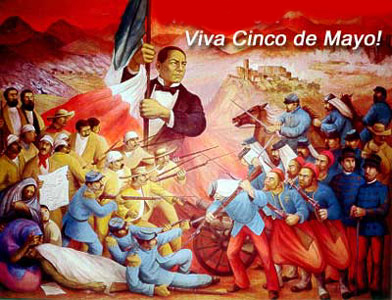I grow up in San Francisco at a time when Cesar Chavez and Dolores Huerta were organizing the United Farm Worker’s Union and marching in the streets demanding better working conditions for Chicano/a migrant workers. Yes, as an African American family involved in the Civil Rights Movement of the ‘60s and Black Power Movement of the ‘70s, my mother insisted we didn’t buy grapes and other produce in our household as a show of solidarity.
Cinco de Mayo when I was growing up was an extension of this spirit of activism. It wasn’t like it is in schools today, a catch-all Latino holiday that’s turned into a national fiesta and in too many cases perpetuates negative Latino stereotypes.
Yes, celebration was always a part of Cinco de Mayo in my multi-racial community when I was a teenager, but the focus was on remembering Mexicans’ push back against would-be oppressors. I think we have forgotten that and have reduced the day to “Mexican independence day” and a reason to party like we do on St. Patrick’s Day.
But it doesn’t commemorate Mexican Independence Day. That’s part of the miseducation around Cinco de Mayo.
Mexican Independence Day is September 16. Here’s the quickie version: Cinco de Mayo commemorates when the Mexican army under General Ignacio Zaragoza defeated the French in the Battle of Puebla in 1862. The uninvited French army decided to invade Mexico. They arrived with almost 7,000 troops marching toward Mexico City. But once they got to the small town of Puebla, a 3,000 man Mexican army made up of farmers and soldiers beat back the bigger French army.
While the French managed to get a foothold in Mexico and occupied the country for almost six years, that battle was a turning point for the resistance to French domination.
This is the story I love about Cinco de Mayo – self-determination and resistance to oppression. This is the story marginalized students of all colors need to hear. It is a day about standing up for yourself.
Sharing this story with culturally and linguistically diverse students isn’t just about racial pride; it’s also about cultivating a growth mindset. Imagine what would have happened if those Mexican soldiers had looked at the size of the French army and said it was impossible to defeat them. They exhibited the ultimate growth mindset.
Every year, as culturally responsive educators, we have an opportunity to get it right and not just do the superficial heroes and holidays thing. We can change the message and the method of how Cinco de Mayo is celebrated by focusing on these three things:
- Get the history right. Make this an opportunity for a teach-in. The U.S. had a role in the French invasion of Mexico. Help people connect the dots. Even young children need to hear the correct versions of our history. That’s how culture is passed from generation to generation.
- Focus on the anti-oppression message. Celebrating has its place, but highlight the reason we celebrate. Teaching marginalized students about self-determination is critical for helping them embrace their own initiative around learning and excelling. It’s one of those noncognitive skills everyone is talking about these days.
- Focus on deep cultural values versus surface culture like food and dance. Too often, especially in elementary schools, we like to “dumb it down” and think young children aren’t ready for the socio-political aspects of major historical events like Cinco de Mayo so we focus on the fun parts — the celebration. We do them a disservice. Events like the Battle of Puebla highlight a culture’s deep values in action. It is our obligation as educators to help them see how we live out our values in everyday life.
Here’s to reclaiming the spirit of those brave Mexican soldiers who pushed back on at the Battle of Puebla on Cinco de Mayo in 1862.


